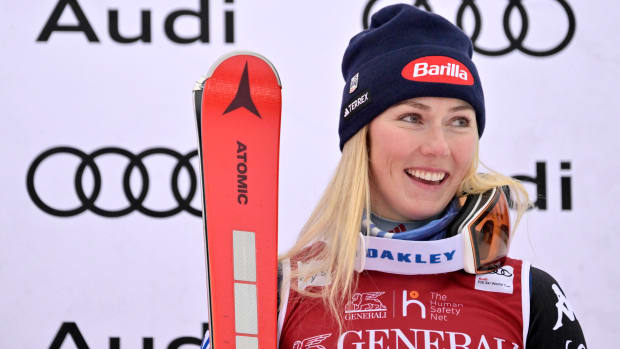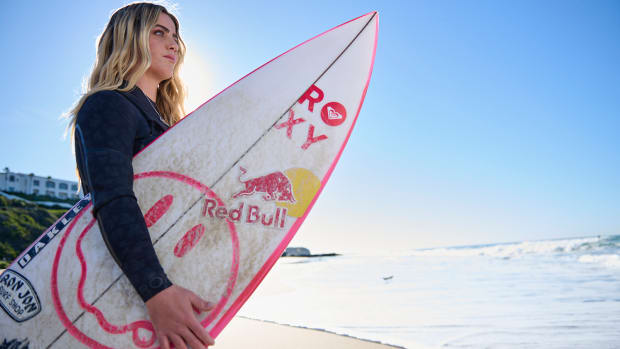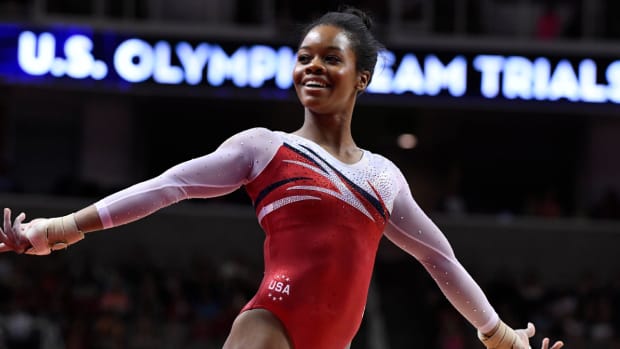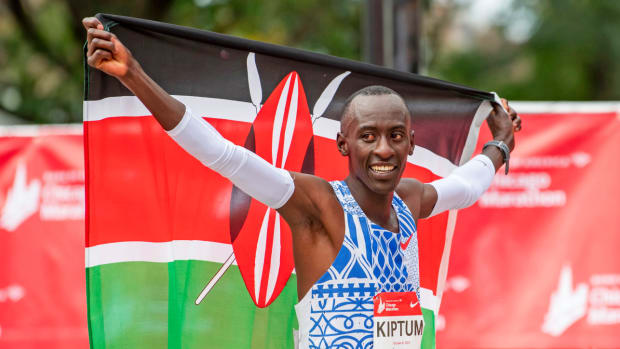Ageless Wonder Oksana Chusovitina Competing in Eighth Olympics at 46
TOKYO – Age has always worked on hyper speed in women’s gymnastics, the sport that sometimes holds retirement parties and college campus visits in the same week. It’s a rarity that the average age of this U.S. team should be north of 20, with a star who is a ripened 24. But days after Simone Biles likely defends her Olympic title, earning what would be a veteran’s haul of six major all-around crowns, she may well be in the vault finals alongside a woman who won an Olympic gold medal five years before Biles was born.
On Sunday, Uzbekistan’s Oksana Chusovitina will compete at the Tokyo Olympics at age 46, or approximately 847 in equestrian years. When Chusovitina was born in 1975, it was the era of 8-track tapes and Magic 8-balls. Nobody was dispensing PEDs, but PEZ dispensers were everywhere. And nobody outside of Onesti, Romania, had heard of Nadia Comaneci, who was a year away from her first Olympics. But out from the age of rotary phones and bellbottoms flipped Chusovitina, a prodigy before 10, a junior champ at 13 and the world champion on floor in 1991. She won gold in the team competition at the Barcelona Games a year later.
Think a three-year career as an elite gymnast is about right? Chusovitina’s has lasted three decades. In that time, her nomadic allegiances have changed as often as her sport. She competed for the Soviet Union, the Commonwealth of Independent States, the Unified Team, her native Uzbekistan, her adopted home of Germany and now Uzbekistan again. She won medals at the Asian Games 24 years apart (Hiroshima in 1994; Jakarta in 2018), including at least one on each of the four apparatuses in her sport. In between, she won vault medals at four different European Championships and amassed 11 world medals, including vault silvers at ages 16 and 36. She has had five skills named for her and her eighth Olympic appearance is the most of any female gymnast in history. “My mother said I was too fragile for gymnastics,” she says.” So mothers don’t know everything.”
At a press conference at the Sydney Games, Chusovitina dismissed suggestions that she was too old for the sport. “Why am I still competing?” she once said. “Well, if you are asking, it is none of your business.” That was 21 years ago. She also suggested the staying power came from her husband Bakhodir Kurbanov, a two-time Olympian in Greco-Roman wrestling. “I don’t want him thinking he’s tougher than me,” she said. Since then, Chusovitina endured operations on her back, a shoulder and an ankle, and was done with gymnastics more often than Elizabeth Taylor was done with husbands. (Chusovitina says, again, that these Olympics will be her last.) As years passed and the trophy case fattened, the publicity also helped Chusovitina raise money for the family’s medical bills. Her son, Alisher, was diagnosed with Leukemia in 2002. He is 22 now, in better health and older than most of his mother’s competitors.
“Each day brings new blessings and new inspiration,” she says. Ask if her head tells her she has over-extended her welcome, she says simply, “Yes, but you know the mind and heart are in different places. Didn’t you not study biology?”
Chusovitina will only compete in her vault specialty in Tokyo, an option that didn’t exist when was first on the national team and every gymnast competed on every apparatus. To be fair, an older competitor can maintain a higher ranking on the vault, because most gymnasts do not actually contest it as an individual event. In both team and all-around competitions, gymnasts perform a single vault for a single score. Those who choose to make themselves eligible for individual medals on that apparatus must execute a second vault, distinctive enough from the first that it comes from a different family or category of vaults, with five families to choose from. One couldn’t do, say, a full-twisting layout Yurchenko vault—with a round-off before the horse—and then simply add an extra half twist in order to create a second vault. Chusovitina keeps a front handspring and Tsukahara—a quarter turn onto the horse—vault in her bag of tricks. The skills are not in the same league as Biles’s, but they are consistent enough that Chusovitina’s execution scores have kept her competitive over changing eras.
Evan the apparatus itself was different when she started. In 2001, the Federation International de Gymnastique (FIG), the sport’s international governing body, changed the dimensions from a traditional vaulting horse—a straight horizontal platform for women; a straight vertical platform for men—to a vaulting table, sloped with additional surface area to allow for more secure hand placement and therefore less hesitation and more abandon, quite apart from the enhanced athletic skills of the gymnasts—in sum, a sure recipe for propulsion.
The scoring system was overhauled, too. The perfect 10, a standard no gymnast had ever reached at an Olympics when Chusovitina was born, had become so commonplace that even with more demanding codes of points each quadrennium, gymnasts were achieving perfect or near-perfect marks too frequently by the time each Olympics arrived. In 2006, the FIG amended the system to include separate scores for content and execution. If Chusovitina started with a base of 6.2 for her vault, she’d need an execution score well above eight on each vault to reach the finals. A 9.9 may be easily recognizable as exceptionally good, but what does a 14,265 look like?
Romania’s Marian Dragulescu, another ageless wonder, is entered in the men’s competition at age 40. Like Chusovitina, Dragulescu competed as an all-arounder, but then gravitated over time to individual events, in his case the complementary disciplines of the vault and floor exercise. He has won world titles on each, but none of his three Olympic medals were golds. Still, men tend to peak later than women in the sport.
Chusovitina has flown over the generational divide in her sport. At this point, a medal would be a long shot, especially with the likes of reigning champ Biles and U.S. specialist Jade Carey in the competition. Thanks to Chusovitina, it will at least be a competition for the aged, if not for the ages. Should she qualify among the top eight vaulters (maximum two per country) on Sunday, Chusovitina will compete in the finals a week later, indifferent to the internal clock that stopped running years ago.
“Gymnastics has enough numbers,” she says. “I don’t need to look at my age.”




